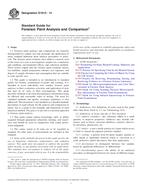We need your consent to use the individual data so that you can see information about your interests, among other things. Click "OK" to give your consent.
ASTM E1610-14
Standard Guide for Forensic Paint Analysis and Comparison
STANDARD published on 15.1.2014
The information about the standard:
Designation standards: ASTM E1610-14
Note: WITHDRAWN
Publication date standards: 15.1.2014
SKU: NS-42352
The number of pages: 13
Approximate weight : 39 g (0.09 lbs)
Country: American technical standard
Category: Technical standards ASTM
The category - similar standards:
Annotation of standard text ASTM E1610-14 :
Keywords:
forensic science, instrumental analysis, paint, paint comparison, ICS Number Code 07.140 (Forensic science), 87.040 (Paints and varnishes)
Additional information
| Significance and Use | ||||||||||||||
|
6.1 This guide is designed to assist the forensic paint examiner in selecting and organizing an analytical scheme for identifying and comparing paints and coatings. The size and condition of the sample(s) will influence the selected analytical scheme. |
||||||||||||||
| 1. Scope | ||||||||||||||
|
1.1 Forensic paint analyses and comparisons are typically distinguished by sample size that precludes the application of many standard industrial paint analysis procedures or protocols. The forensic paint examiner must address concerns such as the issues of a case or investigation, sample size, complexity and condition, environmental effects, and collection methods. These factors require that the forensic paint examiner choose test methods, sample preparation schemes, test sequence, and degree of sample alteration and consumption that are suitable to each specific case. 1.2 This guide is intended as an introduction to standard guides for forensic examination of paints and coatings. It is intended to assist individuals who conduct forensic paint analyses in their evaluation, selection, and application of tests that may be of value to their investigations. This guide describes methods to develop discriminatory information using an efficient and reasonable order of testing. The need for validated methods and quality assurance guidelines is also addressed. This document is not intended as a detailed methods description or rigid scheme for the analysis and comparison of paints, but as a guide to the strengths and limitations of each analytical method. The goal is to provide a consistent approach to forensic paint analysis. 1.3 This guide cannot replace knowledge, skill, or ability acquired through appropriate education, training, and experience and should be used in conjunction with sound professional judgment. 1.4 The values stated in SI units are to be regarded as standard. No other units of measurement are included in this standard. 1.5 Some of the methods discussed in this guide involve the use of dangerous chemicals, temperatures, and radiation sources. This guide does not purport to address the possible safety hazards or precautions associated with its application. This standard does not purport to address all of the safety concerns, if any, associated with its use. It is the responsibility of the user of this standard to establish appropriate safety and health practices and determine the applicability of regulatory requirements prior to use. |
||||||||||||||
| 2. Referenced Documents | ||||||||||||||
|
We recommend:
Technical standards updating
Do you want to make sure you use only the valid technical standards?
We can offer you a solution which will provide you a monthly overview concerning the updating of standards which you use.
Would you like to know more? Look at this page.




 Cookies
Cookies
